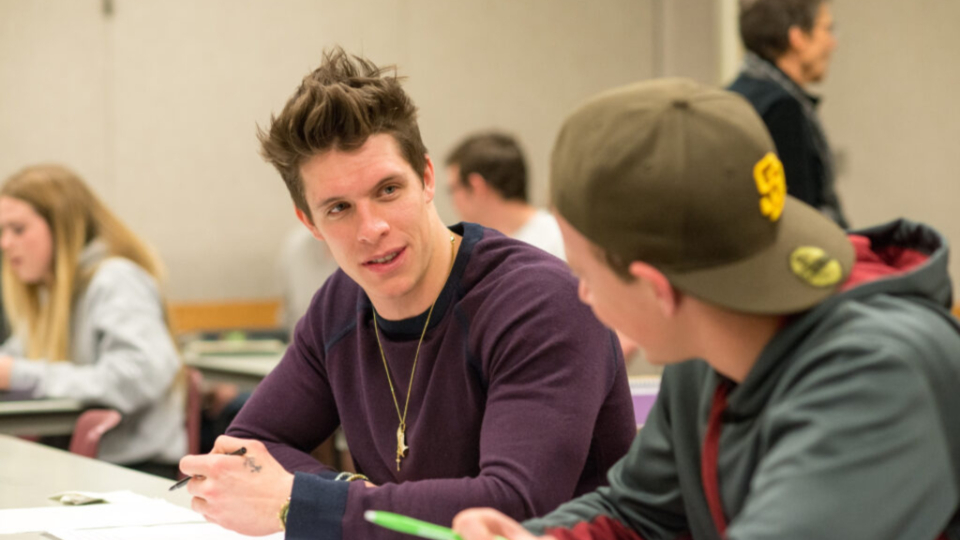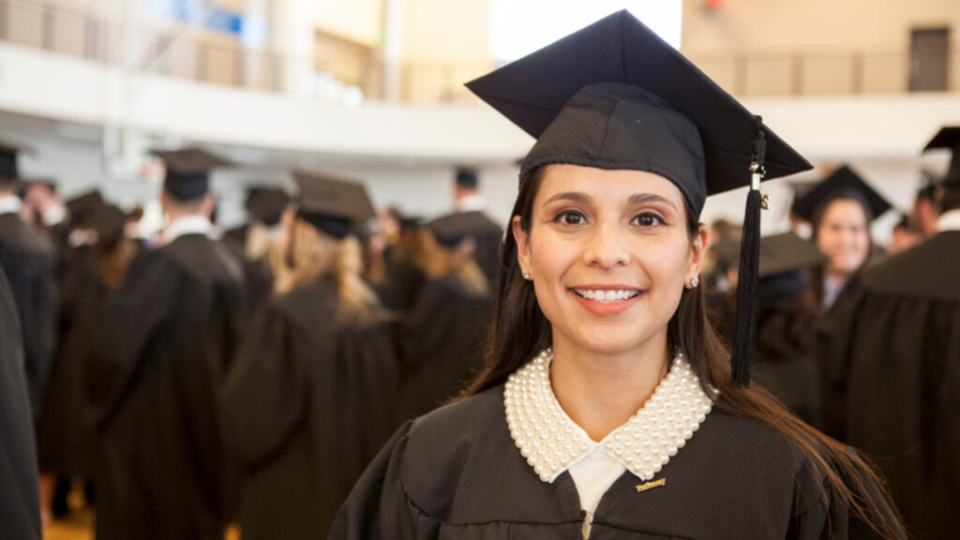| BYU–Pathway student Elizabeth Cameron and her family. Photo by Michael Lewis, courtesy of Church News. All rights reserved. | 1 / 4 |
This story appears here courtesy of TheChurchNews.com. It is not for use by other media.
By Rachel Sterzer Gibson, Church News
More than 50 years ago, as President Henry B. Eyring, second counselor in the First Presidency, was inaugurated as the president of Ricks College, now BYU–Idaho, he expressed a vision for education that seemed impossible at the time.
“We must also find ways for this college to serve young people whose needs are shaped by a great variety of cultures and situations, and who may not be able to come to this campus,” he said. “We will find direct ways to move the blessing of education … from this campus out into the lives of men and women everywhere.”
Today, President Eyring’s words are being fulfilled as the Church’s online university, BYU–Pathway Worldwide, brings a reduced-cost, quality education to those who would never have the opportunity to step foot on a college campus.
“The Lord had been preparing the Church Educational System to do this for a long time,” said BYU–Pathway Worldwide President Clark Gilbert. “But it’s been in this time and season that He’s accelerated the work. And I believe it’s because He’s using education as part of the great gathering of these last days. We see those miracles happening all across the Church.”
In a Church News podcast released on January 12, President Gilbert reflected on the innovative development of Church education and the important role of education in the work of the Lord.

BYU-Pathway-6.jpg
Natalia Manqueo holds her child on her lap as she works on her coursework online through BYU–Pathway in April 2017. Photo by Michael Lewis, courtesy of Church News.All rights reserved.A Vision of What It Can Be
Before President Gilbert ever set foot on the BYU–Idaho campus, where he would eventually serve as president from 2015 to 2017, he worked as a professor at Harvard Business School while Kim B. Clark served as dean. In 2005, when Kim B. Clark left Boston to take the helm of BYU–Idaho, he asked President Gilbert what they could do at BYU–Idaho that would be unique. Because he had worked with inner-city kids in Boston, President Gilbert told him they should look at how to serve everyday students, not just elite students with strong academic backgrounds.
President Clark responded, “Yes, that’s an important population, but the problem is much bigger.”
He then continued, “I’m talking about children in Russia, and in Ghana, and in Brazil, and in the islands; children who are making covenants and keeping covenants, and the Lord will seek to pour blessings out upon their heads, and one of the ways He will do it is through education.”
He then invited President Gilbert “to come with me to Rexburg, to not only rethink education on that campus, but rethink education globally around the Church.”
“I didn’t see the vision early on,” President Gilbert admitted.
And yet, due to their efforts, in 2005 BYU–Idaho created the first-ever PathwayConnect sites in Nampa, Idaho; Mesa, Arizona; and Manhattan, New York. Since then, PathwayConnect has continued to pioneer new ways to connect and educate students around the world, culminating in the launch of BYU–Pathway Worldwide in 2017, with President Gilbert inaugurated as its first president.
BYU–Pathway Worldwide is structured so students begin with a year of entry-level, preparatory coursework in the PathwayConnect program, which includes classes in math, English and religion, facilitated by volunteers. Once the PathwayConnect classes are completed, students can then apply to BYU–Idaho’s online degree programs.

BYU-Pathway-9.jpg
Students at a BYU–Pathway gathering for 18-to-30-year-old students. The meetings are now virtual. Photo by Michael Lewis, courtesy of Church News.All rights reserved.Moving Education Everywhere
Outside President Gilbert’s office in Salt Lake City is a replica of Ken Baxter’s painting titled “Embarkation of the Saints at Liverpool,” which shows early Latter-day Saints boarding a ship on their way to gather in the West. “They were poor, they were uneducated, and they were about to become immigrants,” President Gilbert said.
Out of that group, however, were the seeds that would eventually produce schools such as Brigham Young University and Ricks College/BYU–Idaho. As he looks at the painting, President Gilbert said, he reminds himself and others of the legacy, culture and heritage of education found within the Church.
“But we didn’t come that way,” President Gilbert said. “There was something about our faith that allowed us and pushed us to want to become something more. President Eyring says when you are converted, there’s a desire to learn and become something more, and that often comes through education. President [Russell M.] Nelson describes education as a spiritual responsibility. Elder [Dieter F.] Uchtdorf says for members of the Church, education is not just a good idea, it’s a commandment.”
And yet, despite Latter-day Saints’ legacy of valuing education, many Church members today don’t have access to it, President Gilbert said.
More than 55% of Latter-day Saints in the United States and 85% to 90% in the international Church don’t have a degree. Opening education to those who had never thought they could access it “has been a fundamental miracle in the design of BYU–Pathway from the start,” President Gilbert said.
The Church Educational System includes a portfolio with BYU as the flagship, which focuses on research and has graduate schools and a football team. Then there’s BYU–Idaho, which is teaching focused and undergraduate focused, and BYU–Pathway, which serves a whole different population. “It’s really remarkable as a system,” President Gilbert said.
Doctrine and Covenants 97:3 reads, “I, the Lord, am well pleased that there should be a school in Zion.” Even though there’s a school in Laie, Hawaii; Provo and Salt Lake City, Utah; and Rexburg, Idaho, “Zion is everywhere the stakes of Zion exist, and BYU–Pathways allowed us, for the first time, to really have a school in Zion, wherever Zion is,” President Gilbert said.

BYU-Pathway-10.jpg
Students at a BYU–Pathway gathering for married students or those age 31 and older. The meetings are now virtual. Photo by Michael Lewis, courtesy of Church News.All rights reserved.Tremendous Potential
When President Gilbert and others started exploring students who would come to BYU–Pathway, they interviewed members who were attending Institute but not attending college. They learned that these members believed in the words of the prophets and apostles about the importance of education, President Gilbert said. But when they asked these members why they weren’t pursuing an education, they heard three responses: first, “I can’t afford it;” second, “that’s for smart people” or “I’m not capable;” and third, “I’ve missed my window” or “I’m too old.”
BYU–Pathway, President Gilbert continued, was really designed to remove those barriers. First, it’s affordable. BYU–Pathway currently charges about $75 a credit hour, which is half the price of the community college.
Second, it helps remove the fear. “The whole curriculum was designed to build confidence,” President Gilbert said. And third, it’s accessible to anyone online and can be built to fit anyone’s schedule. “So someone working full-time could build it in ways that allowed them not to have to stop and be in class all week long. And so that’s just opened up tremendous growth.”
In the 10 years since it launched, the program has steadily expanded. In 2020, enrollment reached 50,000 students in 150 countries. The online university saw record enrollment, even through the pandemic.
“I think BYU–Pathway will just keep expanding because the need is so great across the Church, and traditional educational models don’t work for most people. So the affordability, the online nature, the flexible schedule, and the spiritual competence you’ve gained through the program all have made it really transformative, and it’s worked right through the pandemic,” President Gilbert said.
Times and Seasons
When President Gilbert talks about the tremendous changes to Church education over the past 50 years, he talks about times and seasons.
Early on in his time at BYU–Idaho, President Gilbert said President Clark shared with him Doctrine and Covenants 88:73, “Behold, I will hasten my work in its time.” Since then President Gilbert has studied Doctrine and Covenants 88, as well as Section 52 and 53 and the use of the word “time.”
“The Lord talks about working with the laborers in His vineyard, and how in the time and season He would come down and work with them side by side, and the work would accelerate and it would hasten,” President Gilbert said.
Although the Church has been mindful of the need to “move the blessing of education” to men and women everywhere, technology and other factors have been prohibitive. In other words, it wasn’t the right “time and season.”
Today, however, the Lord is hastening His work, President Gilbert said, explaining how their program uses courses offered by BYU–Idaho and Ensign College and religion courses from the Church’s Institute program. They rely on support from 2,500 volunteer Church missionaries all over the world and partner with the Welfare and Self-Reliance Department to help with job placement. Many Pathway students depend on the Wi-Fi available at Church meetinghouses across the globe.
As he thinks about the growth of the program — which “is amazing to behold” — President Gilbert said the real miracle about what’s happening is the Lord is doing His own work. “He’s laboring right beside the laborer in the vineyard, and when that happens, He hastens His work. It’s not just because He cares about education. It’s not just because He cares about the temporal self-reliance of the Saints, and He does on both counts. But I fundamentally believe He’s preparing the world for the return of the Savior. And part of that is the work He’s doing to gather His Church by building capacity and leadership through education all across the world.”
Copyright 2020 Deseret News Publishing Company





